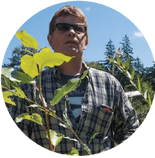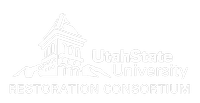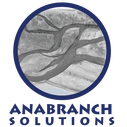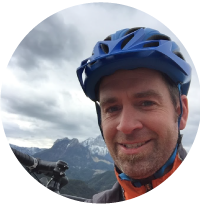Klickitat River Watershed 2022 Field-Based Workshop:
Intro to Low-Tech Process-Based Restoration of Riverscapes
June 7 & 8 in Tepee Creek, WA
Description
This field-based workshop will take place on Tepee Creek in the Klickitat River watershed and is intended to introduce conservationists to ‘low-tech’ process-based (LTPBR) approaches for restoring streams and their associated riparian areas (riverscapes) to benefit fish, wildlife, and Tribal lands. Participants will learn principles guiding low-tech process-based restoration and become familiar with simple, hand-built structures, including Beaver Dam Analogues (BDAs) and Post-Assisted Log Structures (PALS), intended to mimic and promote specific ecosystem processes. The focus of the workshop will be on a set of guiding riverscape and restoration principles, design and construction of different low-tech structures, and the impairments the structures can treat. Planning, assessment, prioritization, and monitoring, though critical to restoration success, will not be covered in detail, but more in-depth information on all aspects of LTPBR restoration can be accessed throug the links below.
We encourage workshop participants to review the lecture material before the workshop (especially Module 1). The Design Manual, the Pocket Guide, and online lecture series are all available online for review. If you only have an hour or so to review lecture materials, here are some recommendations: Scope of the Problem, What Riverscapes Could Be, Broad Umbrella of Low-Tech Restoration, LTPBR Principles, Reading Riverscapes: Mapping Valley Bottoms, Reading Riverscapes: Structural Forcing.
Where to Meet
Tuesday June 07: 9:00 AM @ Yakama Nation Closed Area: Tepee Creek LTPBR Staging Site (46.139110, -121.070430)
Wednesday June 08: 8:30 AM @ Yakama Nation Closed Area: Tepee Creek LTPBR Staging Site (46.139110, -121.070430)
Click on the map below for meeting and stop locations for the workshop.
How to Sign Up
To sign up, please contact Adrianne Grimm (agrimm@ykfp.org) or Jeanette Burkhardt (jeanette@ykfp.org).
What to Bring
- Closed toe footwear, clothes you can get dirty in
- Wading boots or waders
- Water, lunch
- PPE (sun protection, ear protection, work gloves, eye protection, hard hat)
- Some PPE will also be available on-site for work on day 2
COVID-19 Precautions
During the workshop, please follow state, local, and employer guidelines for social distancing and wearing masks.
What Will Be Provided
- LTPBR Manual and Pocket Guide
- Restoration Tools (shovels, buckets, post pounder) and extra safety gear
- Snacks
- PPE if needed
Agenda
- <a href=”></a> Print Agenda
Day 1: Tuesday, June 7
Meeting Location: Yakima Nation Closed Area: Tepee Creek LTPBR Project Staging Site
9:00-9:50: Introductions, Agenda, & Goals of Workshop
Introductions, Goals, Agenda, and Logistics
- Introductions
- Goals/Agenda/Logistics
9:50-1020: Background and Purpose (Pocket Guide p. 5-6, Design Manual Ch.1)
Scope of Problem
- General degradation
- Loss and importance of structure (beavers and wood)
- What was lost?
- Define process-based restoration (contrast with traditional)
10:20-10:30: Break
10:30-11:00: Guiding Principles (Pocket Guide p. 1-4, Design Manual Ch.2)
- Riverscape Principles
- Restoration Principles
11:00-12:00: Context and Conditions (Pocket Guide p. 7-22, Design Manual Ch. 3)
Connecting Observations with goals and objectives
- What’s possible – identify valley bottom features, recovery potential, risk
- Condition assessment - flow regime, geomorphic, riparian, beaver, Uncertainty - adaptive management and expectation management
12:00-1:00: Lunch
1:00-1:30: Low-tech Approaches and Structures
- Beaver ecology and management
- Low-tech toolbox – introduction to methods & structures
1:30-3:00: Designing Low-tech Restoration Structures
- Assessment of site/goals
- Review existing design
3:00-4:30: Building Low-tech Restoration Structures
- Safety demonstration
- Hands on building various structures
4:30-5:00: Wrap up
- Case studies – success and challenges
- Wrap up discussion and questions
Day 2: Wednesday, June 8
Meeting Location: Yakima Nation Closed Area: Tepee Creek LTPBR Project Staging Site
8:30-3:30: Building Low-tech Restoration Structures
- Hands-on construction of various structures
3:30-5:00: Review of workshop and construction
- AS-BUILT review
- Workshop synthesis (review principles) & where to turn for help
Course Materials
Workshop Textbooks
For the workshops, we will rely on the new Design Manual and the Pocket Guide, which are both available free digitally. A hard copy of both will be provided to you in person at the workshop.
Workshop Lectures
Thanks to the generous support of the Natural Resource Conservation Service’s Working Lands for Wildlife, and a grant through Pheasants Forever to Utah State University’s Restoration Consortium and Joe Wheaton’s ET-AL lab are able to deliver a free virtual workshops to NRCS conservationists and their partners. This series was envisioned by Jeremy Maestas (NRCS) and is possible thanks to partner matches by various local organizations in each state and matching funds from Utah State University. This grew out of the successful 2016 Enhancing Mesic Habitat Resilience in Sagebrush Ecosystems Workshop at Utah State University and the 2018 and 2019 workshop series.
The latest iteration of these is a lecture series designed to be presented virtually over five days. The link below provides access to all the lectures on each aspect of low-tech PBR (e.g., planning and assessment, design, implementation) in video and pdf format. These resources will provide more detailed information and links to scientific literature than can be delivered in field-based format.
Additional Resources
Tepee Creek LTPBR Design
The following map outlines the locations of LTPBR structures on Tepee Creek. A full restoration design report can be found here.
Yakama Nation – Beaver Restoration Assessment Tool
The Beaver Restoration Assessment Tool (BRAT) is a capacity model developed to assess the upper limits of riverscapes ability to support beaver dam-building activities. Both existing and historic capacity are estimated using readily available spatial datasets to evaluate five key lines of evidence: 1) a perennial water source, 2) availability of dam building materials, 3) ability to build a dam at baseflow, 4) likelihood of dams to withstand a typical flood, and 5) likelihood that stream gradient would limit or completely eliminate dam building by beaver. BRAT was ran for all the perennial rivers and streams within the Yakama Nation Reservation, which includes portions of the Lower Yakima, and Klickitat watersheds. The analysis also included the Rock Creek, White Salmon, Little White Salmon, and Wind River watersheds. Click on the below link to access the data.
Instruction Team
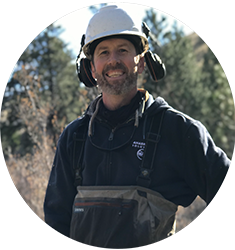
Andrew Hill
Spatial Ecologist & Designer, Anabranch Solutions